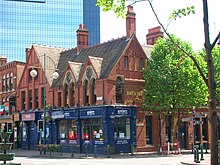Broad Street, Birmingham

Broad Street is a major
Broad Street is also the centre of Birmingham's banking and financial centre. It can boast region head offices of Lloyds Banking Group, Royal Bank of Scotland, Deutsche Bank, HSBC and many other banking organisations. More than 15,000 people are employed in this sector, in this area of Birmingham.
History
Early history
In the 1500s the area which is now known as Broad Street was made up of several schools and guilds such as The Biddles/Free School, Colmore, Shillon/Smallbrooke Guild/School, Billwiggler Croft and Byngas Hall which was later to become a home for the Lloyds Bank family and subsequently Bingley Hall and then Symphony Hall/ICC after Bingley Hall burned down.


In the 1750s, Broad Street was an unnamed country path that ran across Easy Hill from Bewdley Street (now Victoria Square) and Swinford Street (now the top end of New Street) to Five Ways and on to Stourbridge and Bewdley.
However, in the following years, Easy Hill began to develop with the construction of a house by John Baskerville, a local printer and type-face designer. This led to the widening of the street which passed in front of his house. The path was soon removed and an established street was added that ran to the border of Edgbaston and, as a result of its widening, it was named Broad Street.

Land along the street also developed and became a well established neighbourhood as a result of the connections with industry and Edgbaston, an upmarket area. In the 19th century, well established industries were established along the canals at the northern end of the street and residential properties were built at the southern end. Churches of various denominations were also built along the stretch of Broad Street, such as the
Transformation

In the 1970s and 1980s, Broad Street was still very much a suburban high street. However, one prescient early manifestation of the street's future purpose as a fashionable partying district was the Rum Runner nightclub, which from the late 1970s restyled itself after New York City's Studio 54 and later London's Blitz club. The club was best known as the original home base of major 1980s band Duran Duran. It was situated on the South side at the East end of the road from 1964 to 1987 when it was demolished.
During the 1990s, Broad Street was transformed into a dynamic convention, entertainment and
The Broad Street area is home to numerous bars and restaurants, the Brindleyplace development and cultural attractions such as the Ikon Gallery.
Three major
Traffic and transport

There is long standing concern over traffic congestion in the evenings when car drivers attracted by the nightlife are cruising the area. There was a proposal to ban cars during Friday and Saturday evenings[2] and in 1998 there was a plan to ban cars every evening after 8.00 pm.[3]
Broad Street is served by several National Express West Midlands bus routes.[4] The road's only night bus service ceased in 2008.[5]
The West Midlands Metro was extended along Broad Street to Five Ways between 2015 and 2019 with stops at Birmingham Library, Brindleyplace and Five Ways.[6] The proposed SPRINT bus rapid transit route between Birmingham and Quinton would also serve Broad Street.[7]
Buildings and other structures
At its northern end is:
- Centenary Square, with
- Baskerville House
- Hall of Memory
- Library of Birmingham
- The old Masonic Hall, later Central Television - (demolished 2008)
- The Birmingham Municipal Bank, the first municipal bank in the country, later Lloyds TSB, then bought by the council for redevelopment
- The Boulton, Watt and Murdoch statue, recently re-gilded
- The Birmingham Repertory Theatre
- The International Convention Centre and Symphony Hall

- The Crown Inn
- A tunnel (with a grade II listed Martin & Chamberlain building built on it) over the BCN Main Line canal leading to Gas Street Basin and Brindleyplace.
- Hyatt Regency Birmingham Hotel.
- Quayside Tower
- Jury's Inn hotel
Walk of Stars

A 'Walk of Stars', similar to the
Future buildings
Developments planned for the street include
.See also
References
- ISBN 9780300107319.
- ^ [1]; [2]
- ^ "BROAD STREET CAR BAN PLAN; Nightlife. - Birmingham Evening Mail (England) | HighBeam Research". www.highbeam.com. Archived from the original on 6 November 2012. Retrieved 13 January 2022.
- ^ Birmingham National Express West Midlands
- ^ Late night buses in Broad Street to be scrapped Birmingham Mail
- ^ [3]; [4]
- ^ Sprint plan unveiled between Birmingham and Quinton centro
- ^ Ozzy Osbourne to be the first star on the Birmingham Walk of Stars Archived 27 September 2007 at the Wayback Machine - Broad Street Business Improvement District press release, 17 May 2007
- ^ Walk of Stars: Vote for stars Archived 12 October 2007 at the Wayback Machine
- Brum and Brummies: Vol 2 (Chapter 3: 'The Old End' - "From Glebe Land to Working Class Heartland: The Bishopsgate Street Neighbourhood", Page 65), ISBN 1-85858-202-4)
